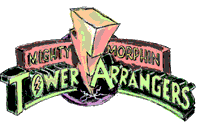The Mighty Morphin Tower Arrangers are:
Chris Barlow
Darren Lewis
& Ted the Robot
About Us
The Mighty Morphin Tower Arrangers are a team entering into the competition, Eurobot 2009: Temples of Atlantis (see www.eurobot.org for details).
Darren Lewis and Chris Barlow are both BSc Engineering Product Design students from Middlesex University in North London, UK.
Although the task for this year's competition is a complex one, the Tower Arrangers' philosophy is to use as few moving parts as possible, and to use natural forces wherever they are available. This should result in an economical, reliable system designed to score a realistic number of points match after match.
This site will follow the team's progress from initial design to final build and our progress through the competition itself.
The Contest
"Eurobot is an amateur robotics contest open to groups of young people from around the world, organised in teams."
"The aims of the contest are to favour the public interest in robotics and encourage hands-on practice of science by young people. Eurobot is intended to take place in a friendly and sporting spirit."
"More than a simple championship for young people or a competition, Eurobot is a friendly opportunity to unleash technical imagination and exchange ideas, know-how, hints and
engineering knowledge around a common challenge. Creativity and interdisciplinary is necessary. Eurobot values fair play, solidarity, creativity and sharing of technical knowledge,
whether it is across technical realisations or project management."
"Eurobot takes place in Europe, but is open to teams from other continents. Countries with more than three teams interested in participating must organise a national qualification in order to select the three teams which will participate to Eurobot finals."
[www.eurobot.org, 2008-2009]
As the day of the UK final approaches, focus has been put on getting the system as efficient as possible. During the rebuild, the claw was modified, bringing the lower support section closer to the bottom in the hope that it would support the lower part of the column better. This didn't work as planned. It turned out that this design made the tube too stiff, so it didn't flex in the right places. This put the claw's pressure on the higher discs, meaning that it wouldn't collect more than 2 or 3 discs at a time.
The design has now been reverted back to the original, with the support claws higher up, and a rubber band pulling the bottom of the claw into a funnel shape to support the column where it needs it most.


Also today, the team has started making changes to the program, to make the stacking process more efficient. The plan is to stay closer to the stacking zone during construction, so that less time is wasted during transit.









